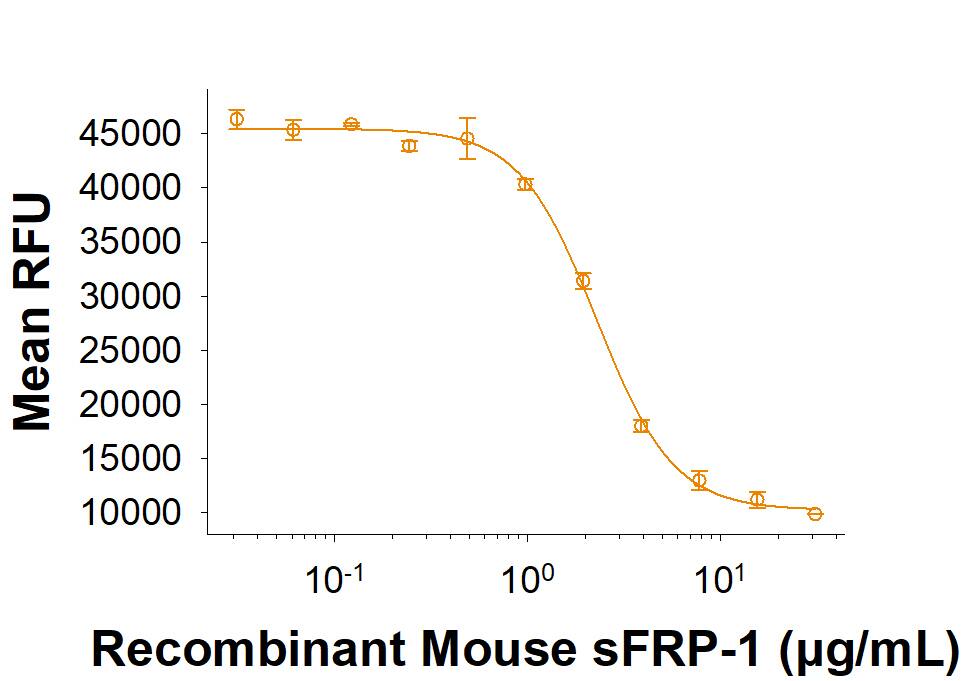Recombinant Mouse sFRP-1 Protein
R&D Systems, part of Bio-Techne | Catalog # 9019-SF

Key Product Details
Product Specifications
Source
Ser32-Lys314
Purity
Endotoxin Level
N-terminal Sequence Analysis
Predicted Molecular Mass
SDS-PAGE
Activity
The ED50 for this effect is 0.600-7.20 μg/mL.
Scientific Data Images for Recombinant Mouse sFRP-1 Protein
Recombinant Mouse sFRP-1 Protein Bioactivity.
Recombinant Mouse sFRP-1 Protein (Catalog # 9019-SF) inhibits Wnt induced TCF reporter activity in HEK293 human embryonic kidney cells. The ED50 for this effect is 0.600-7.20 μg/mL.Formulation, Preparation and Storage
Carrier Free
What does CF mean?CF stands for Carrier Free (CF). We typically add Bovine Serum Albumin (BSA) as a carrier protein to our recombinant proteins. Adding a carrier protein enhances protein stability, increases shelf-life, and allows the recombinant protein to be stored at a more dilute concentration. The carrier free version does not contain BSA.
What formulation is right for me?In general, we advise purchasing the recombinant protein with BSA for use in cell or tissue culture, or as an ELISA standard. In contrast, the carrier free protein is recommended for applications, in which the presence of BSA could interfere.
Carrier: 9019-SF
| Formulation | Lyophilized from a 0.2 μm filtered solution in NaH2PO4 and NaCl with BSA as a carrier protein. |
| Reconstitution | Reconstitute at 500 μg/mL in PBS containing at least 0.1% human or bovine serum albumin. |
| Shipping | The product is shipped at ambient temperature. Upon receipt, store it immediately at the temperature recommended below. |
| Stability & Storage | Use a manual defrost freezer and avoid repeated freeze-thaw cycles.
|
Carrier Free: 9019-SF/CF
| Formulation | Lyophilized from a 0.2 μm filtered solution in NaH2PO4 and NaCl. |
| Reconstitution | Reconstitute at 500 μg/mL in PBS. |
| Shipping | The product is shipped at ambient temperature. Upon receipt, store it immediately at the temperature recommended below. |
| Stability & Storage | Use a manual defrost freezer and avoid repeated freeze-thaw cycles.
|
Background: sFRP-1
References
- Cruciat, C.M. and C. Niehrs (2013) Cold Spring Harb. Perspect. Biol. 5:e015081.
- van Amerongen, R. and R. Nusse (2009) Development 136:3205.
- Rattner, A. et al. (1997) Proc. Natl. Acad. Sci. USA 94:2859.
- Bafico, A. et al. (1999) J. Biol. Chem. 274:16180.
- Dennis, S. et al. (1999) J. Cell Sci. 112:3815.
- Wawrzak, D. et al. (2007) Biochem. Biophys. Res. Commun. 357:1119.
- Yoshino, K. et al. (2001) Mech. Dev. 102:45.
- Barandon, L. et al. (2002) Circulation 108:2282.
- Sklepkiewicz, P. et al. (2015) Circ. Heart Fail. 8:362.
- Barandon, L. et al. (2011) Arterioscler. Thromb. Vasc. Biol. 31:e80.
- Dufourcq, P. et al. (2002) Circ. Res. 106:3097.
- Yokota, T. et al. (2008) J. Immunol. 181:6061.
- Hausler, K.D. et al. (2004) J. Bone Miner. Res. 19:1873.
- Bodine, P.V.N. et al. (2004) Mol. Endocrinol. 18:1222.
- Wang, W.-H. et al. (2008) J. Clin. Invest. 118:1056.
Long Name
Alternate Names
Gene Symbol
UniProt
Additional sFRP-1 Products
Product Documents for Recombinant Mouse sFRP-1 Protein
Product Specific Notices for Recombinant Mouse sFRP-1 Protein
For research use only
